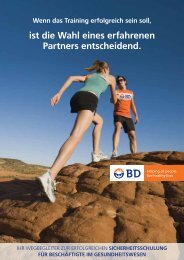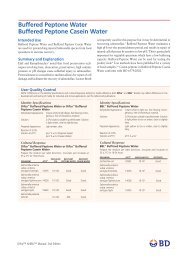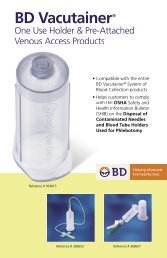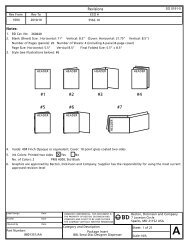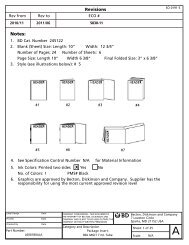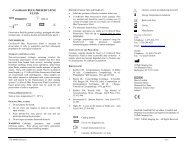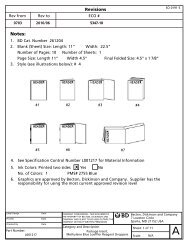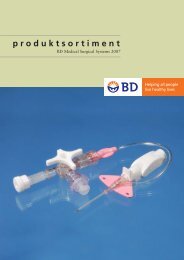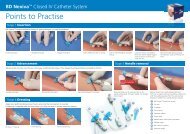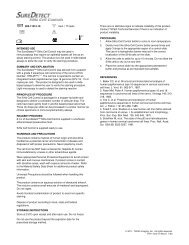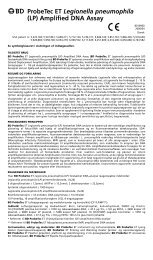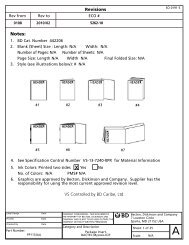Manual method for producing liquid-based cell preparations - BD
Manual method for producing liquid-based cell preparations - BD
Manual method for producing liquid-based cell preparations - BD
Create successful ePaper yourself
Turn your PDF publications into a flip-book with our unique Google optimized e-Paper software.
Procedure<br />
1. In order to ensure a homogenous mixture, the SUREPATH ®<br />
Preservative Fluid Collection Vial must be vortexed <strong>for</strong> 10-<br />
20 seconds and the 0.5 mL aliquot must be removed within<br />
one minute of vortexing.<br />
2. A polypropylene aerosol barrier pipette tip that is sized<br />
appropriately <strong>for</strong> the volume being withdrawn must be used<br />
<strong>for</strong> aliquot removal. Note: Serological pipettes should not be<br />
used. Good laboratory practices must be followed to avoid<br />
introducing contaminants into the SUREPATH ® Preservative<br />
Fluid collection vial or the aliquot. Aliquot removal should<br />
be per<strong>for</strong>med in an appropriate location outside an area<br />
where amplification is per<strong>for</strong>med.<br />
3. Visually check the aliquot material in the pipette <strong>for</strong><br />
evidence of large gross particulates or semi-solids. Evidence<br />
of such material encountered while withdrawing the aliquot<br />
material should prompt return of all the material to the<br />
specimen vial and disqualify the specimen <strong>for</strong> ancillary<br />
testing prior to per<strong>for</strong>ming the Pap test.<br />
4. For instructions on processing the aliquot using the<br />
<strong>BD</strong> ProbeTec CT Q x and GC Q x Amplified DNA Assays,<br />
refer to the assay Package Inserts provided by the<br />
manufacturer.<br />
MATERIALS REQUIRED<br />
Materials Provided<br />
• SUREPATH ® Preservative Fluid Collection Vial<br />
• PREPSTAIN ® Density Reagent<br />
• PREPSTAIN ® Settling Chambers<br />
• SUREPATH ® PreCoat slides<br />
• Centrifuge Tubes<br />
• PREPSTAIN ® Syringing Pipettes<br />
• Aspirator Tips<br />
Materials Required But Not Provided<br />
• Centrifuge<br />
• Slide Racks<br />
• Easy Aspirator (optional)<br />
• Processing Tray (optional)<br />
• Broom type sampling device or endocervical brush/plastic<br />
spatula with detachable head(s)<br />
• Vortex Mixer<br />
• Precision Pipettes with Disposable Tips<br />
• Deionized Water (pH 7.5 to 8.5)<br />
• Isopropanol and Reagent Grade Alcohol<br />
• Staining Reagents<br />
• Clearing Agent, Mounting Media, Coverslips<br />
STORAGE<br />
• SUREPATH ® Preservative Fluid without cytologic samples<br />
may be stored at room temperature (15° to 30° C) <strong>for</strong> up to<br />
36 months from date of manufacture.<br />
• The storage limit <strong>for</strong> SUREPATH ® Preservative Fluid with<br />
cytologic samples is 6 months at refrigerated temperatures<br />
(2° to 10° C) or 4 weeks at room temperature (15° to 30° C).<br />
• SUREPATH ® Preservative Fluid containing cytologic sample<br />
intended <strong>for</strong> use with the <strong>BD</strong> ProbeTec CT Q x and GC Q x<br />
Amplified DNA Assays can be stored and transported <strong>for</strong> up<br />
to 30 days at 2° – 30° C prior to transfer to the Liquid-Based<br />
Cytology Specimen (LBC) Dilution Tubes <strong>for</strong> the<br />
<strong>BD</strong> ProbeTec Q x Amplified DNA Assays.<br />
PROCEDURES<br />
1. After the sample is collected using a Rovers Cervex-Brush ®<br />
or equivalent sampling device, the brush head is rinsed<br />
directly into the fluid, removed from the handle and dropped<br />
into a SUREPATH ® Preservative Fluid vial. The vial is then<br />
tightly capped, labeled, and sent to the laboratory.<br />
2. When sample vials have been accessioned into the lab, place<br />
each vial into the processing tray with a labeled centrifuge<br />
tube pre-filled with 4 ml of PREPSTAIN ® Density Reagent<br />
and a labeled SUREPATH ® PreCoat slide. PREPSTAIN ®<br />
Density Reagent must be added to the tube be<strong>for</strong>e the<br />
sample is added or per<strong>for</strong>mance will be reduced.<br />
3. Vigorously vortex each sample vial <strong>for</strong> 10 – 20 seconds.<br />
(Sufficient volume is available in the SUREPATH ® Preservative<br />
Fluid Collection Vial to allow removal of up to 0.5 mL of<br />
homogenous mixture of <strong>cell</strong>s and fluid <strong>for</strong> ancillary testing,<br />
while still allowing sufficient volume <strong>for</strong> Pap testing. The<br />
aliquoting may be per<strong>for</strong>med after this vortexing step in the<br />
SUREPATH ® LBC Test process.)<br />
• Use the PREPMATE Automated Accessory and<br />
PREPSTAIN ® Syringing Pipettes to transfer the sample.<br />
See the PREPMATE Operators <strong>Manual</strong> <strong>for</strong><br />
instructions. Or<br />
• Remove vial cap. Hold a SUREPATH ® Preservative<br />
Vial in one hand, gently push a PREPSTAIN ® Syringing<br />
Pipettes into the vial until it stops, pointing the end of<br />
the PREPSTAIN ® Syringing Pipettes away from your<br />
face. Invert the vial / PREPSTAIN ® Syringing Pipettes<br />
assembly into the appropriately numbered PREPSTAIN ®<br />
Density Reagent tube. Allow all of the sample solution<br />
to completely drain from the PREPSTAIN ® Syringing<br />
Pipettes be<strong>for</strong>e proceeding. Or<br />
• Remove vial cap. Slowly pour approximately 8 ml of<br />
specimen onto PREPSTAIN ® Density Reagent.<br />
4. Place the tubes into the centrifuge racks according to the<br />
placement sequence diagram in the Procedure <strong>Manual</strong> (each<br />
tube rack has a capacity of 12 tubes). Placement sequence is<br />
critical and must be balanced.<br />
5. Balance the centrifuge tubes by adding Preservative Fluid if<br />
necessary, and centrifuge specimens <strong>for</strong> 2 minutes at 200 x<br />
g.<br />
6. If the Easy Aspirator is used, turn on the Easy Aspirator<br />
system and adjust pressure to 9 ± 2 in Hg. Place clean tips<br />
onto the Easy Aspirator aspirator.<br />
7. Remove centrifuge tube racks from the centrifuge. Slowly<br />
lower the Easy Aspirator tips (or disposable transfer pipettes)<br />
into the centrifuge tubes to aspirate supernatant. The<br />
aspirate device should touch the top of the tubes at<br />
completion. Rinse Aspirator Tips between samples with<br />
water.<br />
8. Centrifuge the tubes <strong>for</strong> 10 minutes at 800 x g to concentrate<br />
the diagnostic component into a <strong>cell</strong> pellet at the bottom of<br />
the tube.<br />
9. Remove the tube rack from the centrifuge. Gently and<br />
quickly decant into the sink. Keeping rack inverted, blot the<br />
tubes carefully on absorbent paper making sure that the <strong>cell</strong><br />
pellet stays in the tube.<br />
10. Label a SUREPATH ® PreCoat slide with each specimen<br />
number, being careful not to touch the surface of the<br />
SUREPATH ® PreCoat slide. Place slides into Slide Rack and<br />
lock a PREPSTAIN ® Settling Chamber onto each slide. The<br />
position of each numbered SUREPATH ® PreCoat slide on the<br />
platter must match to the position of the corresponding<br />
centrifuge tube.<br />
11. Add 4 ml of Deionized Water (pH 7.5-8.0) to each specimen<br />
tube and mix well by vortexing.<br />
12. Working with one sample tube at a time, vortex tube and<br />
immediately transfer 800 µl of <strong>cell</strong> suspension into the<br />
correspondingly numbered PREPSTAIN ® Settling Chamber/<br />
SUREPATH ® PreCoat slide. Repeat <strong>for</strong> each sample.<br />
13. Allow 10 minutes <strong>for</strong> full sedimentation to occur. After the<br />
sedimentation, gently invert the slide platter(s) over the sink<br />
to decant the remaining fluid and blot the excess <strong>liquid</strong> on<br />
absorbent paper.<br />
14. Rinse each PREPSTAIN ® Settling Chamber with 500 µl of<br />
denatured ethanol and decant. Repeat alcohol rinse and<br />
decant the remaining fluid and blot the excess <strong>liquid</strong> on<br />
absorbent paper, allowing them to remain inverted <strong>for</strong> at<br />
least 1 minute.<br />
15. Remove the PREPSTAIN ® Settling Chamber.<br />
16. Stain and coverslip SUREPATH ® Slides.<br />
RESULTS AND INTERPRETATION<br />
• All diagnostic criteria currently utilized in cytology<br />
laboratories <strong>for</strong> conventional Pap smears are applicable to<br />
TRIPATH Imaging ® , Inc. <strong>liquid</strong>-<strong>based</strong> <strong>preparations</strong>.<br />
• Any abnormal or questionable screening observations should<br />
be referred to a pathologist <strong>for</strong> review and diagnosis. Any<br />
<strong>cell</strong>ular morphologic changes are significant and should be<br />
noted.<br />
779-07083-00 Rev G English Page 2



